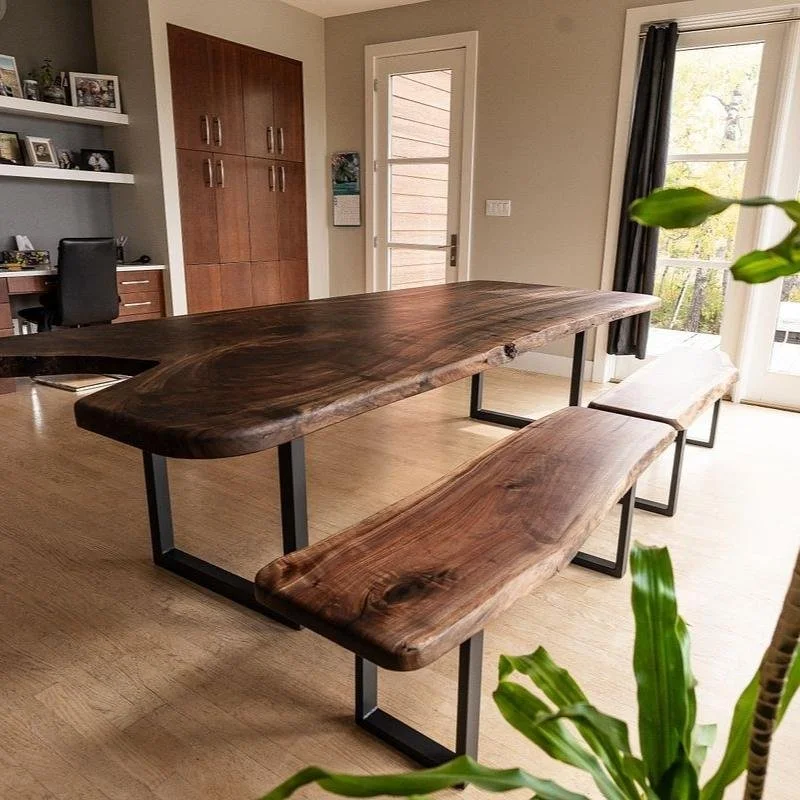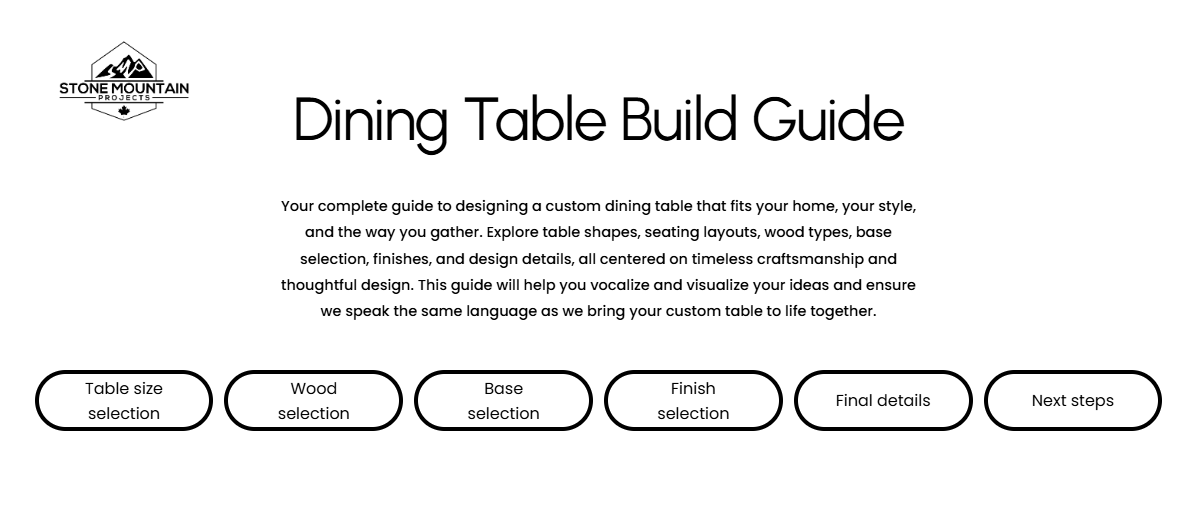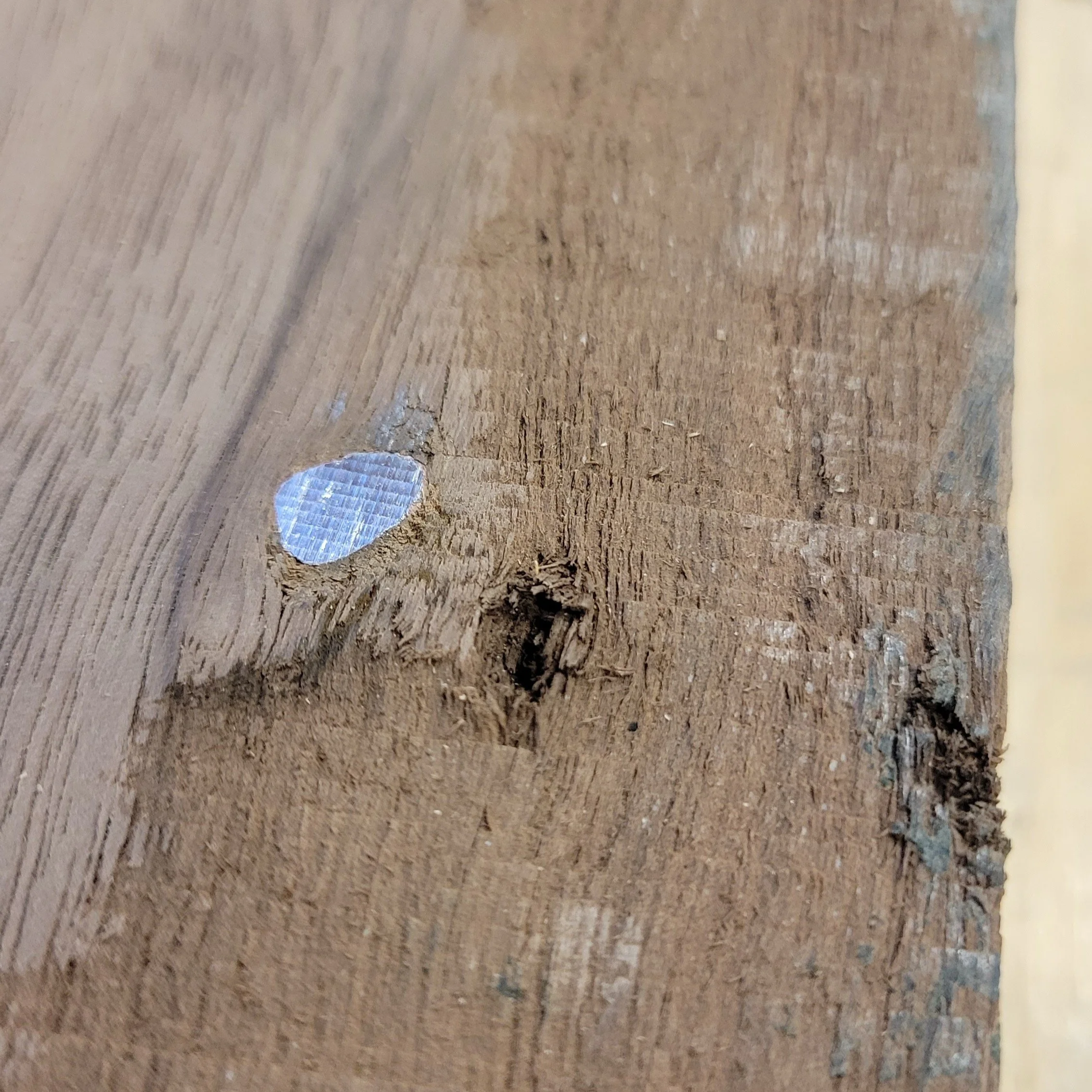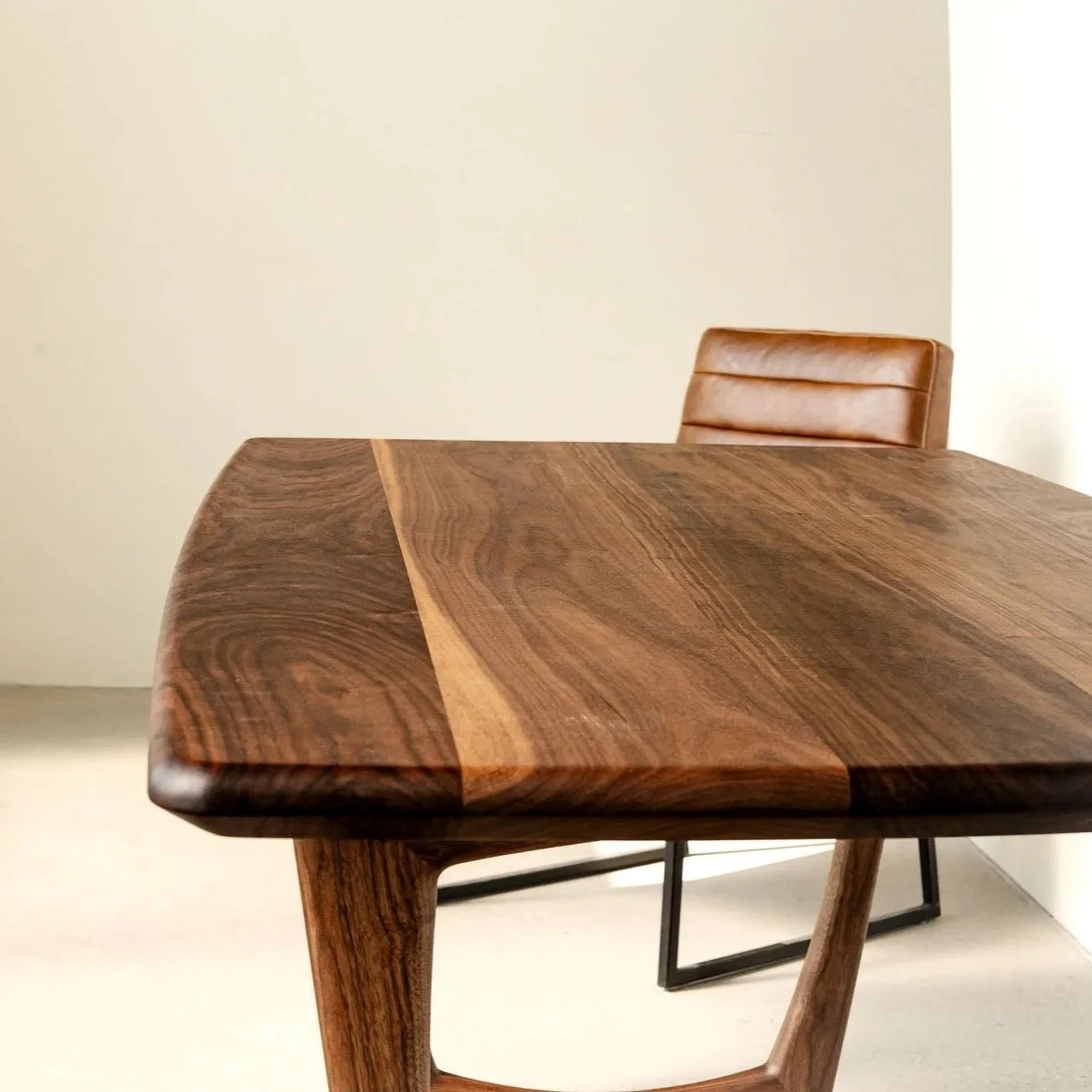Why Investing in a Custom Table Beats Buying A Mass Produced One
Custom tables are not for everyone, and that’s the point. Choosing a custom piece is something to think about carefully because it is not the kind of purchase you make on a whim. In a world where furniture is often treated as temporary and disposable, a custom table stands apart. It is an intentional decision to invest in a piece for your home that is built to last, to grow with you, and to hold the moments that make up your life. It is a piece meant to stay, not to be replaced when the next trend comes along.
When you work with me, or any craftsperson, to build a table, you are not simply buying a piece of furniture off the shelf. You are supporting years of hard earned skill, experience, and attention to detail, grounded in a deep respect for the materials that nature provides. It is an investment that rewards you for years to come, offering a space to gather, create, and hold the memories that shape your home.
I will walk you through why investing in a custom table can completely change how you think about the heart of your home. We will look at how handmade tables differ from mass-produced ones, what makes them stand the test of time, and why they carry a sense of soul that cannot be replicated by machines. By the end, you will see that a custom table is more than a surface for meals or games. It becomes a gathering place for laughter, stories, it’s where moments turn into memories. A well built table reflects not only the hands that made it but also the lives that surround it, a lasting reminder that what we build with care, lasts.
Built to Last: Quality That Endures
When it comes to tables, not all wood is created equal. Many mass-produced pieces are built from veneered particleboard, MDF, or value grade plywood, materials designed to look good for a short time but not to last. Try spilling a coffee or any liquid on one of those surfaces and leaving it for an hour or two. You will come back to a swollen, delaminated mess that is nearly impossible to repair and most likely bound for the landfill.
Custom tables, on the other hand, are built to endure and are typically made from solid hardwood. If you work with me, 99% of the time your table will be built from solid wood. You may be wondering about the remaining 1%. Those are rare cases when I may need to match existing furniture in a client’s home or when I am working on a fine piece that has complex shapes or a design that does not lend itself to using solid wood due to a higher risk of cracking or breaking.
I am not against veneers as a whole, they have their place in fine woodworking. In fact, many of the most beautiful, highly figured logs are sent to veneer mills so their grain and character can be shared across multiple projects instead of just one. But when it comes to my tables, I prefer working with solid lumber. It offers the durability, weight, and natural beauty that make each piece feel unique and rooted, creating a space that is built to build memories.
Below is a comparison chart showing the differences between the two
Traditional Joinery vs. Mechanical Fasteners
One of the biggest differences between a custom built table and a mass produced one lies in how it is made. Traditional techniques, quality materials, and skilled joinery guided by an experienced craftsperson will always outperform a factory built table designed for speed and shipping efficiency.
Traditional Joinery
In custom furniture, the tabletop or base is joined using time-tested woodworking techniques such as mortise and tenon, dovetails, dowels, or splines. These methods create true mechanical strength through precision. Each joint is carefully cut and precisely fit allowing the wood to move with changes in its environment while remaining secure.
That is not to say mass-produced furniture never uses these types of joints, but the difference lies in the execution. Tight tolerances are difficult to standardize in large scale manufacturing, so extra space is often added during production. This added tolerance can lead to unwanted movement in the piece, which is usually corrected with mechanical fasteners or brackets to restore stiffness to the tabletop or base.
Cutting a perfect mortise and tenon or hand cutting dovetails takes time and patience, and it is in that process that the passion and skill of the craftsperson truly shine. When each part is carefully cut and fitted to the next, the result is a stronger, more secure joint that often holds together even without adhesive. These joints may be hidden once the table is assembled, but knowing your table was built by a skilled craftsperson means you can trust the joinery to stay strong and stable for many years to come.
Traditional joinery takes more effort and expertise, but the result is furniture that feels solid, stable, and built to build memories in your home. Even after decades of use, these joints can be repaired, tightened, or refinished without losing their structural integrity.
Mechanical Fasteners
Mass-produced furniture, on the other hand, relies heavily on screws, bolts, cam locks, and metal brackets to hold pieces together. These fasteners are quick to install and ideal for high-speed production and flat-pack shipping, but they often come at the expense of long-term durability.
While convenient for manufacturers, mechanical fasteners can loosen, strip, or pull out of softer materials such as particleboard or MDF after regular use or even after a move or two. Once this happens, repairs are often difficult for the average homeowner and rarely restore full strength. Assembly can also be frustrating, with countless small components that must fit together in a precise sequence using specific tools.
Mechanical fasteners prioritize production speed and portability, not longevity.
In Short
A custom table’s joinery, material selection, and the expertise of an experienced craftsperson provide a durable, stable, and long lasting foundation built to handle the ups and downs of everyday life. Mechanical fasteners and subpar materials, on the other hand, are used for convenience and transport, not for the strength and durability that real daily use demands.
Designed for You and Your Space
Every home is different. The way you gather, the space you have, and the people who sit around your table all shape what makes the perfect design. A custom table gives you the freedom to create something that fits your home and lifestyle rather than settling for what happens to be available online. Find out the right dining table for your home by exploring the most common styles of dining tables.
Each detail is tailored to you and your space. There is no true standard when it comes to custom work, only guidelines and best practices that I use to design and build a table suited to your needs. From there, we adjust and play within those parameters to create a design that feels right for your specific space. A “standard” table width might work most of the time, but if your dining room has different proportions, a standard width can look off balance. Custom work allows us to make those subtle adjustments so your table feels perfectly balanced in your home and reflects your unique style.
Customization also opens the door to special design features that make your table even more functional. Extension leaves for extra seating, custom shaped tops to fit a unique room layout, or mixed material designs are all ways we can tailor your table to fit your space and the way you use it. Even small details like leg placement, edge profile, or base design can completely change how a table looks and feels.
If you want to dive deeper into the design process, be sure to take a look at my Dining Table Build Guide, which walks through every step of designing and building a dining table.
Beyond size and shape, the materials and finishes allow you to bring your personal style to life. You can choose the wood species, tone, and texture that best complement your home, whether it is the warmth of walnut, the brightness of maple, or the timeless character of oak. Finishing options can be tailored for both beauty and practicality, from durable hardwax oils that age gracefully and are easy to maintain, to film finishes that offer maximum protection for busy households.
The result is a table that feels intentional, a piece that belongs in your home because it was designed for your home. It is not just furniture; it is part of how you live, gather, and connect with the people who matter most.
In Short
A custom table is designed around you, your home, and how you live. Every choice, from size and shape to materials and special features, is made to compliment your space and reflect your personal style. The result is a table that feels like it has always belonged, built to fit your home, your life, and the memories you will make around it.
If you would like to know the factors that go into pricing your game table please check out my post how much does a dining table cost.
Built by Hand, Not by Machine
In a world where furniture is often built by automated machines in large factories with little to no staff and shipped out by the hundreds, a handmade table stands apart. While I use tools and machines in my shop, they exist to support precision and efficiency, not to replace craftsmanship. Every piece that comes through my shop passes through my hands from rough lumber to the final finish.
The Process Behind Every Table
The process begins long before the first cut is made. I start by selecting the lumber, taking the time to look at each board, its grain, and its character. I like to layout the boards, flip them around to get a general sense of what the boards are telling me and Instead of cutting around the so called “defects,” I look for ways to highlight them. Knots, interesting grain and color variations are not flaws, they’re part of the story of the tree and, in turn, part of the story of the table. Lumber can often surprise me even as I start milling it, the boards can reveal things that went unnoticed in the initial overview sometimes what I think is going to be a boring side of a board comes alive as I start working it and that can influence the layout and final design of the table. Instead of keeping to hard design constraints I try to work with the wood to see what pieces will end up being the best and where they should be used on the table to make sure they highlight their unique features.
Large manufacturers focus on consistency and speed. They remove these natural features to create perfect, repeatable products. In my shop, the focus is on individuality. No two boards are the same, so no two tables should be either. Even the same style of table I make will have variations truly creating a one of a kind piece. I let the wood itself help guide the design, bringing out its natural beauty and giving each table a personality of its own.
The Difference of a Hands-On Craft
When I’m building, it’s not just about completing an order; it’s about creating something that feels alive. Even after I leave the shop, I find myself thinking about how a piece will come together, how the finish will bring out the grain, how the joinery will look once it’s assembled, how it will feel when it’s finally in someone’s home. I get excited to see the final result and to watch a sketch turn into something real.
That’s something no machine can do. Machines can repeat a process perfectly, day in and day out but they cannot appreciate the subtle grain variations in a board, the bewilderment of finding a bullet lodged in the center of a piece of wood, or the satisfaction of cutting and fitting a joint perfectly. A handmade table carries the touch and thought of its maker in every inch, something that can’t be mass-produced.
Bullet was exposed after running the board through the planer and seeing sparks kick out the front of the machine.
I dug out the bullet with a nail bar and continued to use the board, adding to the story of the table
More Than Furniture — A Connection
Because each table is built by hand, I remember every one. I can tell you who it was for, what inspired the design, and even which boards made up the top. Each project becomes personal. These tables aren’t just products; they’re connections to the people and families who will gather around them for years to come.
One of my favorite builds is the K/W Table, which I made for two of my closest friends. They had just bought their first home and needed an upgraded table. They were looking for second hand or a mass produced style table that fit in their budget. Hearing that sent shivers down my spine, knowing that a table is the heart of the home I couldn’t stand to let two of my best friends move into a new phase of their life using a less than perfect table. Instead I built one for them, not as a gift of furniture, but as a piece to build memories around. I wanted them to have something they could share meals at, celebrate around, and grow old with. Knowing that table will be part of their story for decades is what makes me smile at the end of the day and one of the reasons I know that making furniture is my calling.
The K/W table, highlighting the subtle curved edges and the wonderful variation that walnut has. Photo captured by Dusty media
Closing Thoughts
Every project I take on leaves a small piece of me behind. When families gather for dinner, when friends laugh over board games, or when a couple shares coffee in the morning, I can smile knowing a small part of me is there too. That is what it means to have a custom table made rather than one that is mass produced. It is not just about building a table; it is about creating something that will hold memories long after the sawdust settles.
From the careful selection of materials to the final fit of each joint, a handmade table is something to be cherished and held onto. It becomes the heart of a home, where countless moments are shared with the people who matter most. Investing in a quality table means investing in a piece that will hold those memories for years to come.
If you are looking for a dining table that is more than just furniture, one built with care, craftsmanship, and purpose, I would love to hear from you. Reach out through my contact form or by email, and let us start the conversation about creating something truly special for your home, a table made to last for generations and built to build memories.
Thanks for reading,
Harley
Chief sawdust maker at Stone Mountain Projects








